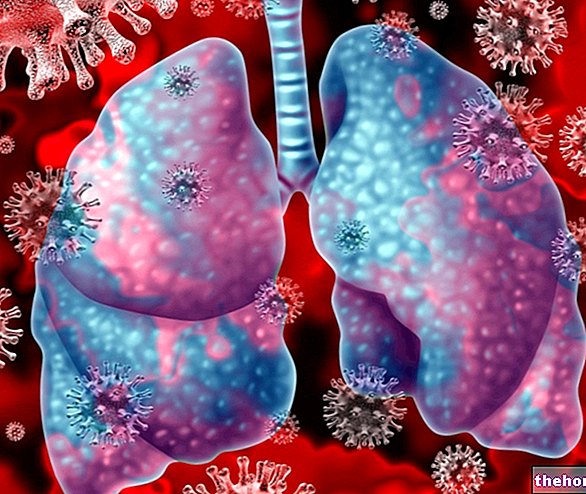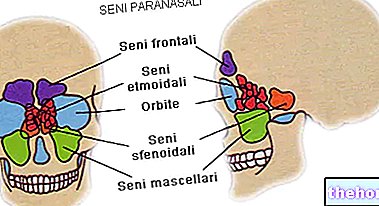Acute bronchitis is typically responsible for symptoms and signs, such as: cough with phlegm, chest pain, runny nose, sore throat, sneezing, wheezing, fever, and widespread muscle aches.
For the diagnosis of acute bronchitis, very often only a physical examination and anamnesis are sufficient; recourse to more specific diagnostic tests occurs in doubtful situations.
As a rule, the treatment of acute bronchitis is based on a therapy aimed at counteracting the triggering causes, combined with symptomatic therapy (ie against the symptoms).
Brief review of the Bronchial Tree
Following the trachea and preceding the pulmonary alveoli, the bronchial tree is the complex section of the lower airways (or lower respiratory tracts), which includes, in order, the primary bronchi, the secondary bronchi, the tertiary bronchi, the bronchioles, the terminal bronchioles and respiratory bronchioles.
According to the most common anatomical view relating to the "bronchial tree," the latter can be divided into two sections: the extrapulmonary tract (ie external to the lungs), to which only the primary bronchi belong, and the intrapulmonary tract (ie internal to the lungs), which include the secondary bronchi, tertiary bronchi, bronchioles, terminal bronchioles and respiratory bronchioles.
Acute bronchitis contrasts with chronic bronchitis. With the expression "chronic bronchitis", doctors mean the "inflammation of the bronchi with gradual onset, mild in terms of symptoms, lasting several weeks and leading to recurrent relapses.
In pathology, chronic bronchitis is a condition of considerable interest, due to its association with morbid conditions such as chronic obstructive pulmonary disease, pulmonary emphysema and asthma.
- Rhinovirus;
- Flu virus;
- Parainfluenza virus;
- Respiratory syncytial virus;
- Adenovirus;
- Coronavirus;
- Metapneumovirus.
Did you know that ...
The transmission to a healthy individual of the typical viruses that cause acute bronchitis generally occurs through contact with contaminated objects or the inhalation of infected saliva droplets emitted by a patient when sneezing, coughing or speaking.
Acute bronchitis of bacterial origin
Episodes of acute bronchitis following a "bacterial infection are relatively uncommon; therefore, recorded cases of acute bacterial bronchitis are numerically limited."
The bacteria capable of causing acute bronchitis include: Mycoplasma pneumoniae, Chlamydia pneumoniae And Bordetella pertussis.
Irritants that cause Acute Bronchitis
The irritants capable of causing acute bronchitis are: cigarette smoke and similar (in other words, tobacco smoke), the so-called environmental pollution, some chemical fumes and some toxic dusts.

In addition to the bronchial tree, these irritants could also inflame the trachea, causing a condition known as tracheitis.
Chronic Lung Diseases associated with Acute Bronchitis
Among the chronic lung diseases associated with episodes of acute bronchitis, a condition well known as asthma, and forms of chronic bronchitis stand out; in the latter case, the resulting acute bronchitis is a sort of sudden worsening of the already present inflammation chronic bronchi.
Other Causes of Acute Bronchitis
Among the so-called other causes of acute bronchitis, gastroesophageal reflux disease deserves a special mention.
Gastroesophageal reflux disease is the medical condition characterized by the continuous repetition of the anomalous phenomenon of rising gastric contents towards the esophagus, whose acidic nature makes it irritating to any organ other than the stomach.
Gastroesophageal reflux disease can play the role of cause of acute bronchitis in the most severe cases, ie when the ascent of the gastric contents goes beyond the esophagus, reaching the larynx and penetrating the airways.
Who is most at risk of acute bronchitis
The subjects most prone to developing acute bronchitis are:
- Those who have contracted a "viral or bacterial infection, affecting the respiratory tract;
- Smokers. As stated earlier, tobacco smoking (smoking) is one of the causes of acute bronchitis;
- Those who live in particularly polluted cities or who, for work reasons, are exposed daily to environmental pollution typical of urban centers;
- Practitioners work daily exposing to bronchial tree irritants;
- Carriers of asthma or chronic bronchitis.
Is Acute Bronchitis Contagious?
Acute bronchitis is a contagious condition when it is viral or bacterial in nature; therefore, if it is due to causes other than viruses and bacteria, it is not a communicable disease.
runny (runny nose);Cough in Acute Bronchitis: How Long Can It Last?
Acute bronchitis is typically responsible for a cough that persists even after the "exhaustion of the inflammatory state for one / two weeks (N.B: remember that acute bronchitis is such when it lasts for a maximum of 10 days).

The persistence of the cough despite the resolution of the inflammation is the result of the characteristic slowness with which the bronchial tree heals, following damage or "offenses" against it.
When to see a doctor?
Among the reasons that should cause an individual with acute bronchitis (or someone who cares for such an individual) to contact their doctor immediately or go to the nearest hospital as soon as possible are:
- The addition to the classic symptomatology of a sudden drop in body weight;
- A worsening of the cough, which becomes barking (barking cough);
- The appearance of severe breathing problems;
- Consolidation of chest pain, which becomes severe;
- A feverish state that exceeds 38 ° C;
- The prolonged permanence of the cough (the persistence of the cough even after the "exhaustion of the" inflammation is to be considered normal, as long as it is not in terms of months).
During the physical examination of a person with presumed acute bronchitis, the evaluation of the breath (which, in the case of a positive test, will present wheezing or rattles) and of the cough (which, in the case of a positive test, will will be catarrhal).
The anamnesis is the particular study of the symptomatology with a view to identifying its triggering / favoring factors; the anamnesis, in fact, consists of an examination of the symptoms, combined with an investigation into elements such as the patient's age, his clinical history, his working activity, his habits, his family history, etc.
In a context of presumed acute bronchitis, the anamnesis allows to establish the causal factors of the current condition (eg: cigarette smoking, in a smoker patient; viral infection, in a patient with a recent cold; exposure to irritants, in a patient with a job at risk; etc.).
What happens in the event of a doubtful diagnosis?
In the event of a doubtful diagnosis, the doctor may follow the physical examination and the medical history:
- A chest x-ray (or chest x-ray).This radiological test is particularly useful when there is a suspicion that the current symptoms depend on pneumonia;
- A culture examination of the sputum. This laboratory examination allows to identify any bacterial infections in progress, for which specific treatment is needed;
- A blood test. This analysis serves to clarify the precise connotations of the present inflammation.
Why is it important to investigate the underlying causes?
The diagnosis of the causes of acute bronchitis is important, because it is on the basis of the triggers that any therapeutic choice is based.
resulting from the presence of fever).No particular pharmacological therapies are therefore necessary.
The use of antibiotics is essential to eliminate from the organism the bacteria that have established the inflammatory state of the bronchi.
Symptomatic therapy
Symptomatic therapy is essential to reduce the patient's suffering during the period in which the latter is undergoing causal therapy.
To ease the symptoms of acute bronchitis, the following may be helpful:
- Taking a non-steroidal anti-inflammatory drug (or NSAID). NSAIDs calm the fever, if present, and any pain that the patient may suffer (eg: chest pain, muscle aches, pain in the throat, etc.) .
An example of a non-steroidal anti-inflammatory drug widely used in acute bronchitis is ibuprofen. - The intake of cough medicines. These medicines are contraindicated in the case of patients under 6 years of age.
- Humidify the air in the home, where you spend most of your time. This ploy improves the picture of respiratory symptoms.




























